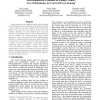Free Online Productivity Tools
i2Speak
i2Symbol
i2OCR
iTex2Img
iWeb2Print
iWeb2Shot
i2Type
iPdf2Split
iPdf2Merge
i2Bopomofo
i2Arabic
i2Style
i2Image
i2PDF
iLatex2Rtf
Sci2ools
VLSID
2002
IEEE
2002
IEEE
Electromigration Avoidance in Analog Circuits: Two Methodologies for Current-Driven Routing
Interconnect with an insufficient width may be subject to electromigration and eventually cause the failure of the circuit at any time during its lifetime. This problem has gotten worse over the last couple of years due to the ongoing reduction of circuit feature sizes. For this reason, it is becoming crucial to address the problems of current densities and electromigration during layout generation. Here we present two new methodologies capable of routing analog multi-terminal signal nets with current-driven wire widths. Our first approach computes a Steiner tree layout satisfying all specified current constraints before performing a DRC- and currentcorrect point-to-point detailed routing. The second methodology is based on a terminal tree which defines a detailed terminal-to-terminal routing sequence. We also discuss successful applications of both methodologies in commercial analog circuits.
Analog Multi-terminal Signal | Computer Architecture | Steiner Tree Layout | Terminal-to-terminal Routing Sequence | VLSID 2002 |
| Added | 01 Dec 2009 |
| Updated | 01 Dec 2009 |
| Type | Conference |
| Year | 2002 |
| Where | VLSID |
| Authors | Jens Lienig, Goeran Jerke, Thorsten Adler |
Comments (0)

